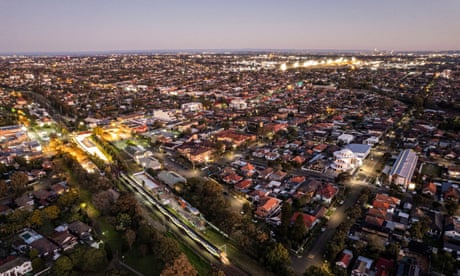- by foxnews
- 08 Apr 2025
‘Latte line’: poverty rises in parts of Sydney as gap hardens between city’s east and west
‘Latte line’: poverty rises in parts of Sydney as gap hardens between city’s east and west
- by theguardian
- 27 Apr 2023
- in news

The "latte line" dividing Sydney's western and eastern suburbs is hardening, with new research identifying deepening levels of poverty within already disadvantaged areas and groups.
A report commissioned by the New South Wales Council of Social Services (Ncoss) also found one in five renters are among more than 1 million people living in poverty in the state.
The report revealed the overall poverty rate has remained largely stable but that it has worsened for key groups in Sydney including people over 65, people living alone and the unemployed. The situation has likely worsened since the data was collected at the 2021 census due to the rising cost of living and other financial pressures.
Poverty was highly concentrated in some of Sydney's west and south-west suburbs, where nearly one in three people live in poverty, a gap of almost 30 percentage points when compared to rates near the coast and in some northern suburbs where less than 5% fall below the poverty line.
The report defined the poverty line as being 50% below the median household income. Adjustments were made depending on the number and age of people living in each household.
Ncoss's chief executive, Joanna Quilty, said the inequity warranted urgent attention and needed to be a focus for the new state government.
"It's a hardening of that latte line - we are seeing that divide absolutely firm up and become more pronounced," she said.
The data is categorised by Statistical Area 2 (SA2) - unique geographic areas created by the Australian Bureau of Statistics that contain about 10,000 people and often reflect suburban boundaries.
The state-wide poverty rate was 13.4%, and in greater Sydney it was 13.2%.
More than half of the areas in Greater Sydney saw an increase in poverty rates between 2016 and 2021. Some of the largest increases were in the south and west, including in Macquarie Fields and Cabramatta West, which saw rises of more than five percentage points. But the largest increase, of 12.6 percentage points, was in Cooks Hill in Newcastle.
Quilty said the lack of social and affordable housing was causing issues across all areas and all demographics.
"We have more and more groups experiencing really appalling circumstances that are just not fathomable in a state that's as wealthy as we are," she said.
"The housing crisis is now at such a level that it's on everyone's lips, it's impacting more and more of the population. It's seeping into the middle-class households, it's got intergenerational impacts, it's impacting our society on every level."
The NSW government has flagged an interest in setting ambitious social housing targets but is yet to release any, nor a plan of how it intends to build more homes.
Impact Economics' lead economist, Angela Jackson, said governments needed to look not just at the cost of eradicating poverty but at the human and economic cost of poverty on the state.
"It should be our number one economic priority to be reducing the rates of poverty but we've just seen a complete failure over the last 20 or 30 years," she said.
She said rising rents, interest rate hikes and inflation causing higher food prices were all placing greater stress on people, especially those on fixed incomes and those relying on government payments.
According to the report, there are several areas where everyone in public housing is living under the poverty line, including in inner Sydney and the Richmond-Tweed area.
Many areas in Northern NSW - which has been hit by repeated natural disasters - experienced particularly high increases in poverty since 2016.
The report also revealed almost 50,000 NSW residents over 65 years old had fallen into poverty between 2016 and 2021, accounting for the largest growth of all age brackets.
More than half of older women living in private rentals were in poverty - up from a quarter just five years earlier.
Outside greater Sydney, more than 90% of areas had an increase in the poverty rate for mortgage holders, compared with about 40% of areas within Sydney.
Quilty said the government needed to listen to experts and the people living in poverty.
"They're often not the loudest voices because they are busy just surviving," she said.
She said the government needed to learn from the pandemic experience.
"We do have the levers available and we saw that during Covid."
- by foxnews
- descember 09, 2016
Ancient settlement reveals remains of 1,800-year-old dog, baffling experts: 'Preserved quite well'
Archaeologists have recently unearthed the remarkably well-preserved remains of a dog from ancient Rome, shedding light on the widespread practice of ritual sacrifice in antiquity.
read more


